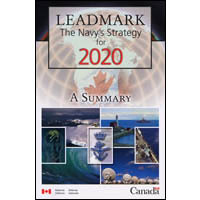This article is a part of The Hunt for Strategic September, a week of analysis on the relevance of strategic guidance to today’s maritime strategy(ies). As part of the week we have encouraged our friendly international contributors to provide some perspective on their national and alliance strategic guidance issues.
As the United States undertakes a rigorous review of its strategic guidance, Canadian defence planners should take note. An update is expected for an important element of American maritime strategy, Cooperative Seapower for the 21st Century, which calls for operations to be carried out ‘ideally’ in concert with allies. The Quadrennial Defence Review (QDR), to be issued next year, will assess the threats and challenges faced by the United States and set out long-term plans on how to develop American capabilities accordingly.
 In contrast, Canada lacks an equivalent to the QDR, with any strategic review conducted on an ad hoc basis. In 2001, a weighty tome was published by Canada’s Department of National Defence (DND), entitled Leadmark: The Navy’s Strategy for 2020. As this was developed and released prior to the September 11th attacks and such operations as Active Endeavour, an update came in 2005, entitled Securing Canada’s Ocean Frontiers: Charting the Course from Leadmark. Since then, no further updates to Canada’s maritime strategy have been released. In 2008, DND released the Canada First Defence Strategy (CFDS), but this is primarily concerned with funding and procurement issues for the Canadian Forces as a whole. The CFDS is already badly dated; where it does briefly outline the Canadian Forces’ strategic objectives, it identifies security for the 2010 Winter Olympics as a top priority.
In contrast, Canada lacks an equivalent to the QDR, with any strategic review conducted on an ad hoc basis. In 2001, a weighty tome was published by Canada’s Department of National Defence (DND), entitled Leadmark: The Navy’s Strategy for 2020. As this was developed and released prior to the September 11th attacks and such operations as Active Endeavour, an update came in 2005, entitled Securing Canada’s Ocean Frontiers: Charting the Course from Leadmark. Since then, no further updates to Canada’s maritime strategy have been released. In 2008, DND released the Canada First Defence Strategy (CFDS), but this is primarily concerned with funding and procurement issues for the Canadian Forces as a whole. The CFDS is already badly dated; where it does briefly outline the Canadian Forces’ strategic objectives, it identifies security for the 2010 Winter Olympics as a top priority.
Canada could benefit greatly from an equivalent process to the QDR. One of the objectives of such a review should be to determine whether the Royal Canadian Navy is still in strategic lockstep with its allies. If a significant gap in capabilities and/or priorities is found, an update on the scale of Leadmark 2.0 may be necessary in order to ensure Canada is capable of upholding its commitments to its allies. There is some cause for concern as to whether Canada is already falling behind, making the need for a defence review all the more urgent.
In 2011, as a follow-up to the CFDS, the National Shipbuilding Procurement Strategy (NSPS) was released. While some of the particulars are hazy, the NSPS is intended to modernize the Royal Canadian Navy, replacing many vessels that have been operating well past their intended date of retirement. For example, the Joint Support Ship Project will see Canada’s two Protecteur-class auxiliary vessels replaced with three Berlin-class replenishment ships. However, perhaps the most ambitious aspect of the NSPS is the Single Class Surface Combatant Project, which calls for the replacement of Canada’s 12 Halifax-class frigates and three Iroquois-class destroyers with 15 vessels of as yet unknown capabilities or classification. However, there are strong indications that these new vessels will be similar in many respects to the current Halifax-class frigate.
As some observers have noted, the United States Navy has placed greater attention in recent years on the littoral zone. Meanwhile, Canada remains focused on a traditional naval task force role, lacking sealift capabilities or any means of reliably deploying in littoral waters. If the Littoral Combat Ship is the shape of things to come, Canada’s expected frigates (or at least frigate-like vessels) may not be fully compatible. Though the Royal Canadian Navy will remain useful for maritime interdiction and generally supporting the United States in ensuring continental defence, Canada may find itself largely ignored by American strategists in favour of other, more compatible allies. Had DND undertaken reviews similar to the QDR, some course correction could have been made to Leadmark, its successor, and the subsequent NSPS. One can only hope that the Single Class Surface Combatant once unveiled will prove to be something capable of participating actively alongside US and NATO maritime forces.
Even so, calls for an update to Canadian strategic guidance have been limited. In analyzing Canadian public opinion, the original Leadmark laments, “some Canadians are unaware of their navy, and do not understand where ‘naval’ fits into a ‘national’ strategy.” 12 years later, one may wonder whether parliamentarians have also forgotten their navy, hoping that haphazard fleet-replacement will be a sufficient remedy.
Paul Pryce is a Junior Research Fellow at the Atlantic Council of Canada. With degrees in political science from universities in both Canada and Estonia, he has previously worked in conflict resolution as a Research Fellow with the OSCE Parliamentary Assembly. His research interests include African security issues and NATO-Russia relations.



